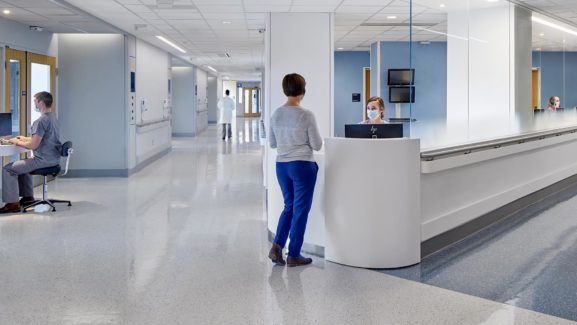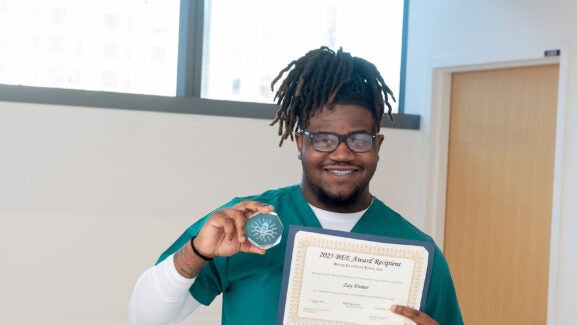

Safety and Security: Mastering Our Winter Weather Response
Unlike New Orleans and beach towns along the Gulf Coast, here in Virginia we’re accustomed to navigating freezing temperatures, snow, and ice. Yet, every winter storm brings unique challenges, and UVA Health System has to be prepared for every possibility — from frozen pipes and slippery sidewalks to downed trees and power outages — to ensure the safety of our patients and staff, and to maintain our ability to provide exceptional care.
Staying Ahead of the Storm
Our first step in preparing for a winter weather event begins days prior to the storm, when the Emergency Management team starts carefully monitoring local and regional weather forecasts. If a storm is imminent, the Emergency Management team initiates a call with the UVA Health Weather Assessment Team, which is comprised of leaders from across the health system. This team meets regularly during severe weather events to evaluate conditions and make informed decisions about operations. Some of the key considerations are the storm’s potential impact on:
- Road and walkway conditions
- Staffing
- Parking and transportation
- Building infrastructure, including power and water systems
“We’re looking at everything within the Health System — not just University Medical Center, but system-wide,” says Shane Anderson, Director of Emergency Management. “There are around 300 locations.”
Clear Communication: A Cornerstone of Safety
Should operational changes be necessary during a weather event, the Weather Assessment Team and Emergency Management team inform our staff and the public of any modifications being made to standard operating procedures. Team members receive email alerts before, during and after the event. For the most comprehensive information and real-time updates, staff turn to the UVA Health Status Board.
This tool, developed by Anderson in 2023, is an online hub that communicates team member reporting status and local-level operations status detail for University Medical Center, UVA Community Health, ambulatory clinics, and other locations across the health system. It allows designated local leaders or “zone captains” to update the status of clinics in real time, which is invaluable since the impact of weather often varies across our operating area.
“We want our employees to be checking their emails. That’s where they’re going to receive regular notifications about a storm,” says Anderson. “But the status board is always there as ‘the source of truth.’ It is accessible on any device, so you can check it on your iPhone, your iPad, Android, and computer.”
“A lot of team members do not access their health system email from home, so knowing how to access the status board is important,” adds Janine Smith, RN, BSN, Clinical Program Coordinator for Team Member Injury Prevention
Taking Action Takes Collaboration
There are multiple teams involved in helping implement our storm response. One team that has boots on the ground even before the first snowflake has fallen is our Health System Physical Plant (HSPP) team. “The last storm we had, we scheduled staff to come in the day before to prepare, and they worked overnight in shifts to clear the snow,” says Kevin Fox, Director of Facilities Planning and Capital Development.
Every surface across the health system campus — every sidewalk, crosswalk, stairway and parking lot — is treated and cleared to ensure that our patients and staff can access our facilities safely. As the storm progresses, the HSPP team works with the Team Member Injury Prevention team to respond in real time to hazards reported by staff in BeSafe.
“We work collaboratively with Kevin and his team,” says Smith. “If we get a complaint or report in BeSafe, we respond right away and take pictures of the area. That’s why we want to make sure staff report in a timely manner so that we know exactly where the hazard is and we can address the problem before an injury occurs.”
HSPP also collaborates with academic teams and outside agencies to make sure surface areas adjacent to our health system campus are safe for travel. “Some areas are not under our purview,” says Fox. “We make sure that we're clearing what we can within the span of our control, and if we can't, then we determine who we can contact to help get that hazard mitigated.”
Weathering the Storm Together
Getting through any major weather event requires all of us to stay alert and informed, and to remain diligent and proactive. “With any event, we do something that's called an '“'After Action Report,' and we look at strengths and opportunities for improvement based on feedback from the Weather Assessment Team or other crucial stakeholders,” says Anderson.
Anderson shared some of the major successes from the January storm: “I think the Hospitality and Support Services team did really well with offering team member accommodations at University Medical Center. I think HSPP did a phenomenal job cleaning the sidewalks and limiting slips trips and falls, so a huge shout out to HSPP for their hard work. The Weather Assessment Team process is flowing very smoothly. This is something that we've built over the course of the last two years. I think having the UVA Health Status Board, looking at things holistically across the entire enterprise is very helpful, bringing the entire system together, ensuring that our communications are aligned, and that our decision-making process is aligned is certainly a strength.”
While we can be proud of our response to the January storm, winter isn’t over yet, so another snow event is a possibility. Here are some safety tips and reminders to help us weather the next storm safely:
Be Aware
- Monitor weather forecasts via the National Weather Service and local media.
- Consider an emergency alert app, like UVA Ready.
- Look for UVA Health Emergency Management updates via email and text.
- Monitor the UVA Health Status Board for team member reporting status and local-level operations status detail for UVA Health medical centers, clinics, and other locations across the health system.
Be Prepared
- Protect yourself and family with a Family Emergency Plan.
- Pet owners should have plans to care for their animals.
- Put together a basic disaster supplies kit, or “Go-Kit” if you do not already have one. During severe weather, you may need to arrive early to work or be held over.
Be Proactive
- Consider your personal safety first. our employees live in a wide geographic area where road and weather conditions can vary greatly.
- Dress warmly and in layers, and always wear appropriate footwear.
- Clear all snow and ice from cars before taking to the roads after a storm.
- Plan ahead and add extra time for safe travel. View road conditions from the Virginia Department of Transportation’s Virginia 511 site and mobile app.
- Remember that roads, parking areas, and walkways may have slick spots even after being treated. Be aware of what’s underfoot, go slowly and avoid walking across surfaces that have not been cleared.
- Report an icy patch or area that needs clearing at a UVA Health facility by calling 434.924.2267.
- If you slip or fall, or if you see a potential hazard on UVA Health grounds, submit a report via BeSafe right away.
Latest News



